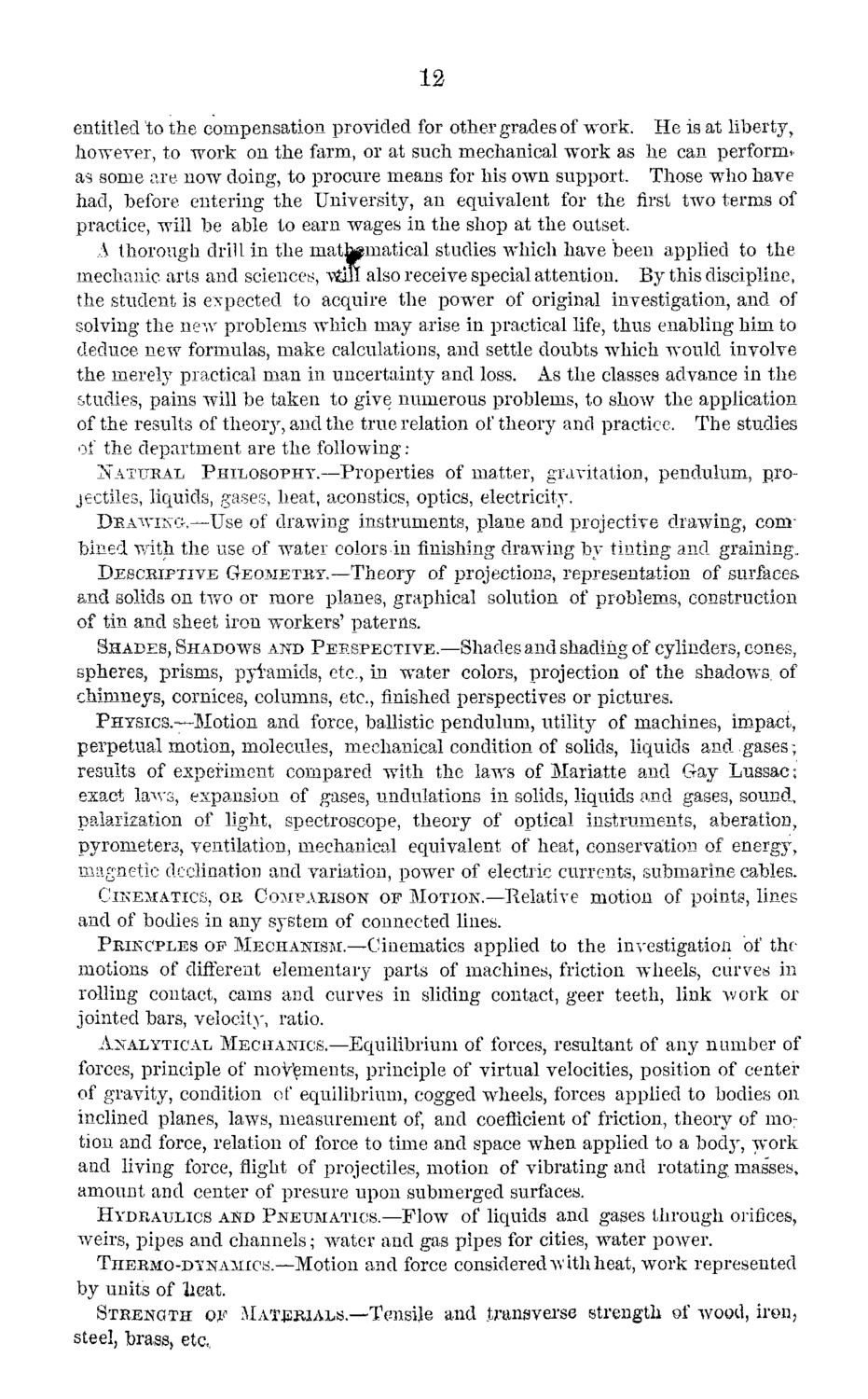| |
| |
Caption: Course Catalog - 1869-1870
This is a reduced-resolution page image for fast online browsing.

EXTRACTED TEXT FROM PAGE:
12 entitled to the compensation provided for other grades of work. He is at liberty, however, to work on the farm, or at such mechanical work as he can performas some are now doing, to procure means for his own support. Those who have had, before entering the University, an equivalent for the first two terms of practice, will be able to earn wages in the shop at the outset. A thorough drill in the mathematical studies which have been applied to the mechanic arts and sciences, \4Jit also receive special attention. By this discipline, the student is expected to acquire the power of original investigation, and of solving the new problems which may arise in practical life, thus enabling him to deduce new formulas, make calculations, and settle doubts which would involve the merely practical man in uncertainty and loss. As the classes advance in the studies, pains will be taken to give numerous problems, to show the application of the results of theory, and the true relation of theory and practice. The studies of the department are the following : NATURAL PHILOSOPHY.—Properties of matter, gravitation, pendulum, projectiles, liquids, gases, heat, acoustics, optics, electricity. DRAWING-,—Use of drawing instruments, plane and protective drawing, conr bined with the use of water colors in finishing drawing by tinting and. graining. DESCBIPTIVE GEOMETRY.—Theory of projections, representation of surfaces and solids on two or more planes, graphical solution of problems, construction of tin and sheet iron workers' paterns. SHADES, SHADOWS AND PERSPECTIVE.—Shades and shading of cylinders, cones, spheres, prisms, pyramids, etc., in water colors, projection of the shadows, of chimneys, cornices, columns, etc., finished perspectives or pictures. PHYSICS.—Motion and force, ballistic pendulum, utility of machines, impact, perpetual motion, molecules, mechanical condition of solids, liquids and gases; results of experiment compared with the laws of Mariatte and Gay Lussac; exact laws, expansion of gases, undulations in solids, liquids and gases, sound, palarization of light, spectroscope, theory of optical instruments, aberation, pyrometers, ventilation, mechanical equivalent of heat, conservation of energy, magnetic declination and variation, power of electric currents, submarine cables. CINEMATICS, OK COMPARISON OF MOTION.—Relative motion of points, lines and of bodies in any system of connected lines. PRINCIPLES OP MECHANISM.—Cinematics applied to the investigation of the motions of different elementary parts of machines, friction wheels, curves in rolling contact, cams and curves in sliding contact, geer teeth, link work or jointed bars, velocity, ratio. ANALYTICAL MECHANICS.—Equilibrium of forces, resultant of any number of forces, principle of movements, principle of virtual velocities, position of center of gravity, condition of equilibrium, cogged wheels, forces applied to bodies on inclined planes, laws, measurement of, and coefficient of friction, theory of mo : tion and force, relation of force to time and space when applied to a body, work and living force, flight of projectiles, motion of vibrating and rotating masses, amount and center of presure upon submerged surfaces. HYDRAULICS AND PNEUMATICS.—Flow of liquids and gases through orifices, weirs, pipes and channels; water and gas pipes for cities, water power. TnEBMo-DYNAiiics.—Motion and force considered with heat, work represented by units of lieat. STRENGTH OF MATERIALS.—Tensile and transverse strength of wood, iron, steel, brass, etc.
| |